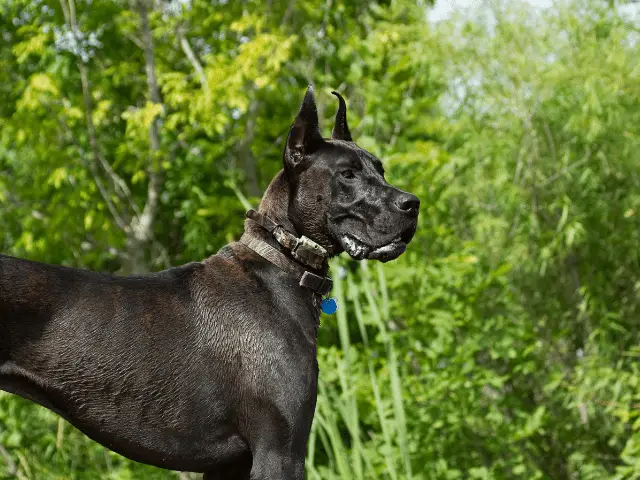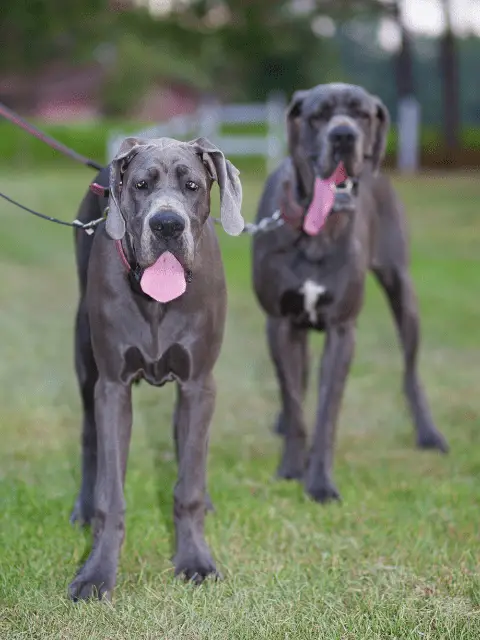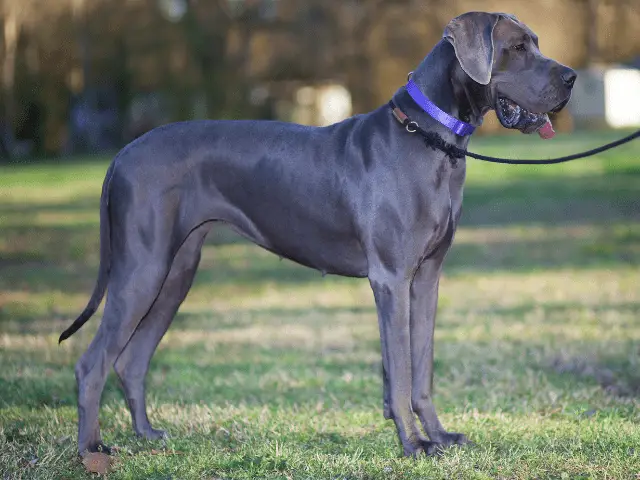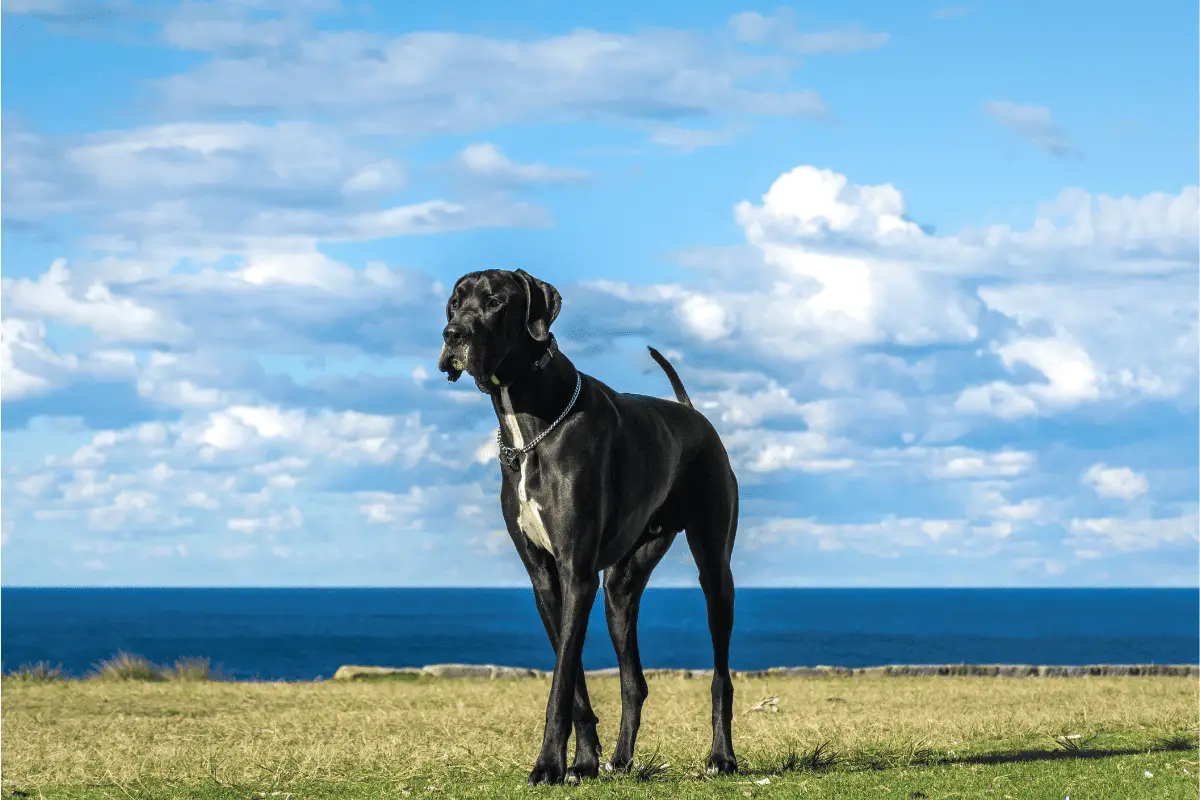Great Danes are a famous and historic breed, originating in 16th century Germany but having become popular throughout Europe and the US in the many years since.
Thanks to their hunting origins as the dogs of European nobility, they are strong, regal-looking, elegant dogs, although today they are best known for their size – adult Great Danes weigh a minimum of 100 pounds, despite being primarily a companion breed in the modern day.
The question we’re going to discuss here though is do these gentle giants make good hiking companions?
Can You Hike with A Great Dane?

The Great Dane is not exactly a sporting breed, and especially considering its past use for hunting, some may wonder whether it is appropriate to hike your Great Dane on local trails.
The truth is that Great Danes are gentle giants, unlikely to be aggressive towards any other animal or towards humans. Their prey drive is typically quite low, and most of them are easy-going dogs. They love to spend as much time as possible by their owner’s side, so they will happily accompany you on any adventure you choose, including hiking.
Great Danes’ powerful muscles and strong build will allow them to tackle any trail you choose, although their stamina may not hold out for the duration of the hike.
That said, proper training and preparation can be especially important due to the breed’s giant size. You and your Great Dane will both enjoy the hike more if you are fully prepared and your pup knows how to behave during the trip.
It’s important to find the right trail for you and your dog, prepare yourselves beforehand, and know things to look out for after the hike is over. As long as you keep all this in mind, hiking with your Great Dane will be a great experience.
Finding the Right Trail
Finding an appropriate trail is an important part of any hike, but the importance is even greater when hiking with your dog, and doubly so for Great Danes.
This probably goes without saying, but the first step to finding the right trail is making sure that the trails you are considering are dog-friendly.
It seems like all parks, hiking trails, and similar locations would allow domestic animals since they certainly have a variety of wild animals, but there are many which don’t and it’s important to be respectful of the park’s rules.
Great Danes can hardly go unnoticed at the park, either, so there would be no chance of circumventing pet restrictions even if you wanted to.
It’s also a good idea to choose a trail that you are already familiar with, and if you are not, then you should be sure to take a map.
Great Danes are more likely than other breeds to have health issues like blindness or deafness. If your Great Dane is afflicted with one of these, then it’s important to know whether the trail you have chosen will be safe for them to navigate.
You’ll also have a hard time lifting or carrying your Great Dane, so in the event of an emergency, knowing how to get help quickly will come in handy.
The terrain of the trail itself will also be a big factor, but only you can know what will be best for your Great Dane.
For example, climbing up rocks or over fallen trees can be difficult for many Great Danes, but some are able to navigate these obstacles easily. Depending on the material of the trail and the weather you are hiking in, you may need to invest in booties to protect your dog’s paws from heat or to give them extra traction in slippery conditions.
Before the Hike

We’ve already mentioned scouting for the right trail and bringing key items like a map, but there are also other things you can do to prepare yourself and your Great Dane for your hike together.
One thing that you can do to prepare your dog for the hike is to make sure that they are properly trained and socialized. Despite their massive size, Great Danes can get nervous in new surroundings or when meeting new people or animals.
You can largely prevent this by socializing your Great Dane from an early age with other dogs and other humans so that they get used to encountering new friends and will not be startled on the trail.
Basic obedience training commands like sit, stay, and heel can help you keep your dog safely by your side in case you encounter any dangerous terrain or dangerous creatures during the hike. Great Danes are smart animals and they love to follow their owner’s lead, so you should have no trouble teaching them simple commands.
Great Danes are naturally strong, but endurance doesn’t come as easily to them, so you should slowly build up the length of your hikes before taking them on any serious excursions. Start with short hikes and gradually increase the length or difficulty to get your dog accustomed to the type of hike that you want to take them on.
Their stamina should improve, but always be prepared to turn around earlier than you planned if they are showing signs of fatigue. This gradual building up of hike length will also toughen their paw pads to protect them against abrasive terrain, although you may want to consider booties for them if you will be hiking on very rocky or otherwise hazardous trails.
Finally, don’t forget your poop bags, water bowl, and ID (your dog’s, as well as your own), since you’re guaranteed to need them at some point.
When you feel overly prepared, that’s a sign that you’re ready to head out to the trails!
After the Hike
When hiking with your Great Dane, the adventure isn’t over when you get off the trail.
Depending on the weather and trail you chose, you may need to dry off your pup’s paws, legs, or entire body before they get back in the car or walk across the rug – they are excellent at finding any hint of a muddy puddle to splash through. (As a bonus, the towels that you pack can also be used to keep cozy on the car ride, especially in cold weather.)
You’ll also want to check your Great Dane for ticks after coming back from a hike. Ticks are more common in certain areas and at certain times of year, but they can still be found across the country and throughout the whole year, so it’s important not to slack when it comes to checking for ticks.
The Great Dane’s short coat makes it easier to check them for ticks than long-haired breeds, but there is a lot of surface area to cover. It used to be common practice to crop Great Dane ears to prevent injury when hunting, but now that they are mainly companion dogs.
Most owners now choose to leave their Dane’s ears alone – be sure to check in and around those floppy ears, as well.
Great Danes have a fast metabolism, due to their size, and they need to eat a ton of food to meet their caloric needs.
When their activity level increases, as it will when you start bringing them on hikes, they will need even more food to make up for it. Be ready to increase meal sizes or provide snacks after a big outing, because your Great Dane will definitely be hungry.
Great Dane Health and Safety Considerations

Giant breeds like Great Danes are at a higher risk for a number of health conditions, which is something to keep in mind when taking yours for a hike.
Bloat (gastric dilation-volvulus) is the leading cause of death for Great Danes, and bloat is more likely to occur when a dog exercises too soon after eating a meal. To prevent bloat, wait at least 40 minutes to an hour after your Great Dane eats before taking them on a hike.
Hip dysplasia is also a common problem in Great Danes, especially as they age.
The risk of hip dysplasia does not at all mean that you can’t take your Great Dane for a hike, but if they are experiencing any joint problems, it’s important that you keep an eye on the issue and not embark on a more difficult hike than your dog can handle, to prevent things from getting and worse.
Although hip dysplasia is heritable, you can reduce the likelihood or the severity of the condition by avoiding hiking with your Great Dane before they reach full adult size and being quick to address any joint injuries they sustain.
Some Great Danes experience a condition in which the vertebrae of the spine, due to growing at a rapid rate, put pressure on the spinal cord itself. This pressure can cause underdeveloped leg strength, among other things, and the condition often heals itself over time; if not, it can also be treated with surgery.
However, this weakness is another health concern to watch out for if you know or suspect that your Great Dane has this condition.
Final Thoughts
Great Danes can make great hiking companions! With some proper planning, you and your Great Dane can absolutely enjoy some outdoor trails together. Start slow, check in with your Great Dane often and slowly build up their endurance as they get more experience.
See you on the trail!

